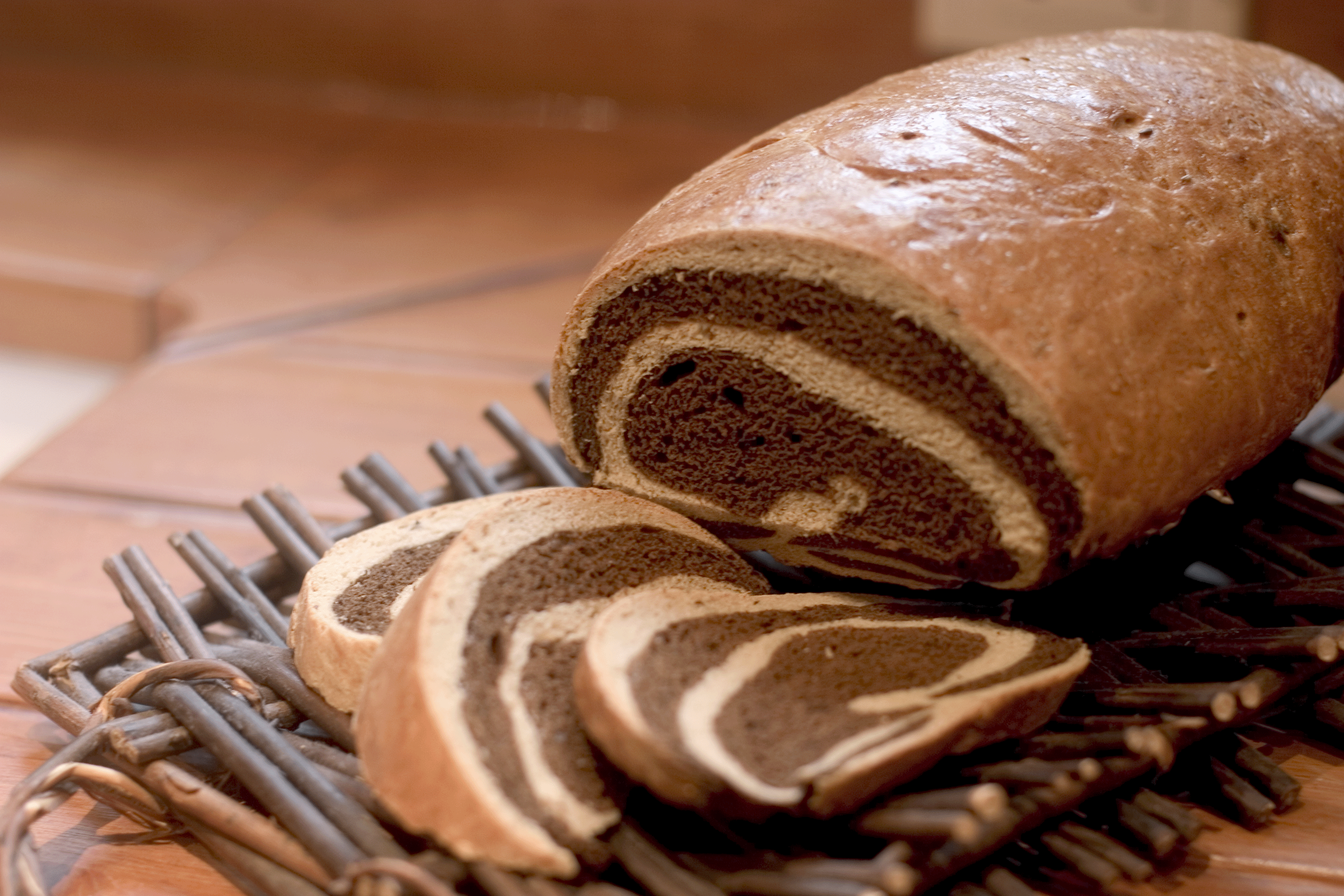 I would never consider eating the same thing for dinner every night for two years straight, yet I went through a phase where I ate 2 slices of rye bread, toasted with salted butter and sour cherry jam every morning for breakfast for about 2 years. Every morning, the same breakfast! I have since moved on, to oat squares cereal with bananas in the winter and blueberries in the summer. But I still fondly remember my rye bread mornings.
I would never consider eating the same thing for dinner every night for two years straight, yet I went through a phase where I ate 2 slices of rye bread, toasted with salted butter and sour cherry jam every morning for breakfast for about 2 years. Every morning, the same breakfast! I have since moved on, to oat squares cereal with bananas in the winter and blueberries in the summer. But I still fondly remember my rye bread mornings.
The rye bread came from the Rideau Bakery, in Ottawa, where I live. Their rye bread is my standard for excellence. They use a sourdough base that some say has been going for decades. So, it was with some trepidation that I began this week’s Bread Baker’s Apprentice Challenge bread, Marbled Rye.
I had to order some special supplies from King Arthur Flour to create this bread. Professional bakers use a type of flour, called clear flour, in their rye bread. This is the flour that clears the first sifting (to separate out the bran and germ), still retains some of the finer bran fiber from the outer endosperm of the wheat berry and is thus coarser and contains higher levels of ash. This is the flour New York City bakers have always used for their signature Jewish-style rye breads.
The second item I ordered was caramel powder. This is basically powdered all-natural caramelized corn syrup. It’s used to give the dark rye it’s deep brown colour. We had the option of using coffee powder, but according to other BBA challengers, coffee powder did not stain the dough enough to produce that deep brown colour I was after. I was seduced by the photo of the marble swirl in the book, and I wanted to reproduce it.
In addition to the clear flour and caramel powder, the remaining ingredients include rye flour, salt, yeast, caraway seeds, molasses shortening and water.
The process involves making 2 batches of dough, exactly the same, except for the addition of the caramel powder for the dark rye batch. We are warned not to overmix the bread as rye flour contains “pentosan gums” which interfere with the gluten development. In short, overmixing can lead to a very gummy dough. I was very careful to knead only for a short 4 minutes. The caramel powder added a beautiful rich brown colour to the dough.
The dough is left to ferment at room temperature for about an hour and a half, or until it doubles in size.
In order to create the marbled effect, we had several oprions. We could make a spiral or a bull’s eye ( a perfect circle of dark rye, encased by light rye). The other 2 options were to braid the 2 doughs or to create a marbled effect by making small balls of dough of the 2 different colours and then smooshing them together to create a marbled effect. I had visions of my play-doh days and the marbled creations I crafted then, were not something I wanted to repeat here. As an aside, I have to say that my mom never minded if we mixed the play-doh colours. She just bought us fresh new play-doh so we could create anew.
Since this recipe made 2 loaves I decided to attempt the spiral and the braid. For the spiral, you roll out 2 dark ovals and 2 light ovals and then stack them up, alternating colours and roll them up to form a loaf. This was so much fun to do. My creative spirit came alive.
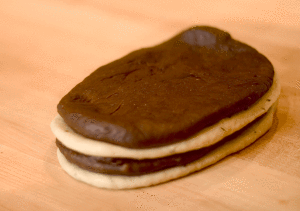
Once rolled up, the bread can be put in a loaf pan or left on a sheet pan, to proof freestyle. I really like the more rustic look of a free-form loaf so I did not use the loaf pan.
While the spiral loaf was proofing, I went on to create my braided marbled rye. The remaining dark and light doughs were divided in half and rolled out into 4 strands, each about 12 inches long. Then they were braided, using the 4 strand formula. There is an excellent video on the web that demonstrates theis braiding technique.
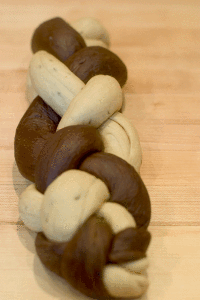
Both loaves were proofed until they had doubled in size. That took about 75 minutes. Then they were egg-washed and put into a 350 degree oven for about 45 minutes. The marble one cooked a bit faster as it was a little thinner and longer than the spiral loaf. Once out of the oven, it took all my willpower not to slice into them. I was so excited to see how they looked on the inside. After 2 hours, I sliced. I was overwhelmed at how lovely these loaves were. They were deliciious for dinner that night and even better as the week progressed, toasted for breakfast.
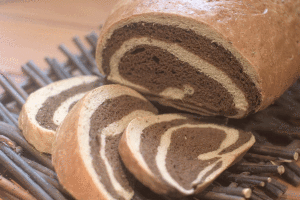

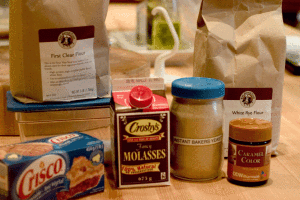
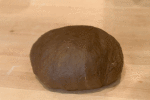
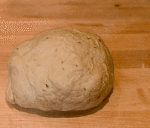
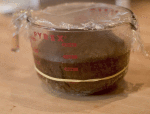
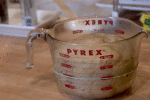
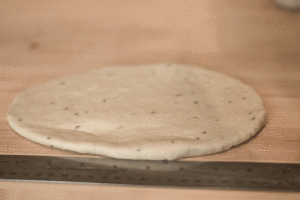
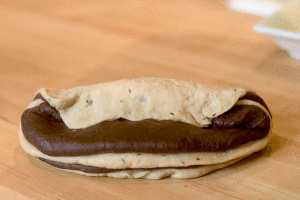
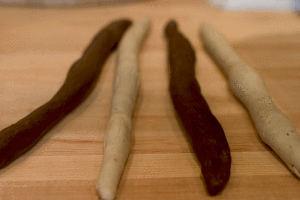
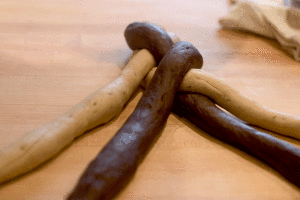
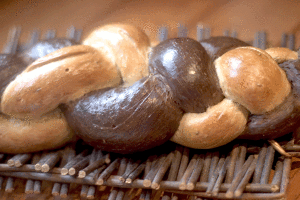
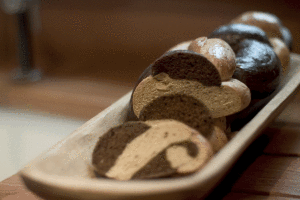
Those are beautiful breads (fantastic photos, too). You are really cranking through the BBA. Thanks for the tips on the special ingredients you ordered. I am going to attempt to get somewhat caught up with the rest of the BBA Challenge group this weekend by making one or two of the most recent breads and continuing forward from there. It’s a perfect excuse for some online shopping at King Arthur.
How much of the powder did you use? My husband could easily eat two slices of this for breakfast, two slices for dinner, quickly approaching roundness.
I used the powdered caramel in mine and found that 5 teaspoons gave me the color I was looking for.
Hi Anne Marie, I used 2 tablespoons of powder, mixed with 2 tablespoons of water. Have a great day Cindy
These are absolutely beautiful loaves! Great job with the recipe.
Beautiful loaves! I like the way the braided loaf turned out. Nice job, as always.
Absolutely gorgeous! Very nice idea to do the braided loaf – if one day I try this recipe again, I think I’ll go the braided route.
I am still a little shaken by my performance with the marbled rye…
Absolutely gorgeous marbled rye Cindy. The swirl (and the contrast) is perfect!
I seriously love braided breads and that braided marble rye looks incredible. Great job!
Wow! I just stumbled upon your website. I too am doing the same thing (but you’re ahead of me) by doing a bread a week from this book. I haven’t read any of the other posts, but I will do so, as I’m curious as you how your other recipes turned out. My rye was excellent, and I wish I would have done what you did with the one loaf and one braided. I loved doing the Challah braided, and would have liked to done for this. Good luck and happy baking.
Hi Brian, thanks for stopping by. Good luck with the challenge. It’s lots of fun and you can learn lots by reading other BBA challengers posts before you tackle a new bread.
Pingback: Bread Baker’s Apprentice Challenge: Marbled Rye — Pinch My Salt
Pingback: Is Rye Paleo? | The Paleo Diet Food List
Im looking for the recipe for this bread. It looks and sounds so amazing! I know this is an old post, hope you can help!
Thanks Emily, this was a great bread. I participated in the Bread Baker’s Apprentice Challenge, where I baked and blogged about every single recipe in Peter Reinhart’s amazing book (Bread Baker’s Apprentice). Since I blogged about every single recipe, I did not include the recipes as I really did not feel it was fair to reprint his entire book.
You might be able to find the recipe online from another blogger, but if you are serious about bread baking, I suggest buying his book. It is fantastic.